Maximizing the harvest of fresh basil from the garden involves various preservation methods. This flavorful herb is versatile and can be used in a variety of dishes, from Italian to Thai cuisine. The best part is that basil is easy to grow and maintain.
Before diving into the different methods of preserving basil, it’s important to know the best time to harvest basil and how to properly clean the leaves to ensure optimal freshness.
Key Takeaways:
- Preserving fresh basil can help you enjoy its flavors throughout the year.
- Harvest basil in the morning when the essential oils are the strongest and clean the leaves before preserving.
- Basil can be preserved through methods such as making basil-infused olive oil, freezing basil in cubes, salt drying, and dehydrating.
The Best Time to Harvest Basil
The best time to harvest basil is in the morning when the essential oils are strongest. It is recommended to wait until the morning dew has dried and before the heat of the afternoon sun has set in to begin harvesting. This ensures that the leaves are dry and not wilted, making them easier to handle and store.
When harvesting basil, it is important to use sharp pruning shears or scissors to avoid damaging the plant. Cut the stem back to the first or second set of leaves from the top, leaving enough foliage on the plant to allow for continued growth. Avoid harvesting more than one-third of the plant at a time, as this can weaken the plant and affect future growth.
Before harvesting, it is important to ensure that the basil leaves have been thoroughly cleaned. Use a gentle spray of water to remove dirt and insects, and pat the leaves dry with a towel or allow them to air dry.
Basil can be preserved using various methods, such as making basil infused olive oil, basil and olive oil cubes, salt drying, and dehydrating. Freezing basil cubes is considered the easiest way to preserve basil and have fresh basil all year round. Simply blend fresh basil leaves and olive oil in a food processor, pour the mixture into ice cube trays, and freeze. It is also possible to make pesto and other herb sauces to preserve basil.
Harvesting basil regularly by pinching or pruning the stems back to a strong set of side shoots promotes new growth and increases yield. Different types of basil, such as Genovese, Thai, lemon, and Greek basil, require different harvesting methods based on their unique characteristics. Whether you’re using fresh basil in your cooking or preserving it for future use, harvesting at the right time and using proper techniques will ensure a bountiful crop and delicious results.

Cleaning Basil Leaves
Before preservation, the basil leaves should be thoroughly cleaned by hosing off any dirt and insects. Basil leaves are susceptible to pests such as aphids and spider mites, which can damage the leaves. To prevent infestations, regularly check the plants for signs of pests and remove any affected leaves.
Once the leaves have been harvested, rinse them under cool running water and pat them dry with a clean paper towel. It is important to remove all excess moisture to prevent mold growth. Discard any leaves that are discolored, wilted, or damaged.
If the leaves are still dirty after rinsing, fill a large bowl with cool water and add a tablespoon of vinegar. Gently swish the basil leaves in the solution for a few minutes, then rinse them again under cool running water and pat them dry.

Properly cleaning basil leaves is important for preserving their flavor and freshness. Taking the time to remove any dirt or pests will ensure that your basil-infused oil or dried basil leaves are free from impurities and safe to consume.
Basil-Infused Olive Oil
One method of preservation is making basil-infused olive oil by warming extra virgin olive oil with fresh basil leaves. This process allows you to enjoy the fresh taste of basil long after the growing season ends. To make basil-infused olive oil, you will need:
- Extra-virgin olive oil
- Fresh basil leaves
- Optional ingredients: garlic, dried basil, and red pepper flakes
Begin by washing the fresh basil leaves and let them dry completely before placing them in a double boiler with the olive oil. Gently warm the oil for 30 to 60 minutes on the lowest temperature setting, being careful not to let it heat up. This allows the basil leaves to infuse with the oil, creating a delicious taste and aroma.
Once cooled, strain the basil and store the infused oil in a glass bottle for up to one year. Use the oil for salad dressings, marinades, or drizzle over roasted vegetables for added flavor.
Alternatively, you can preserve basil by making basil and olive oil cubes. After harvesting and washing the basil leaves, chop them into small pieces and place them in ice cube trays. Pour olive oil over the leaves and freeze until solid. Transfer the basil cubes to a freezer-safe container for future use.
Basil can also be preserved by salt drying or dehydrating. To salt dry basil, layer sea salt and basil leaves in a glass jar and store it in the refrigerator. To dehydrate basil, clean and dry the leaves, then lay them on dehydrator trays and dry them at a temperature between 95°F and 115°F.
Harvesting basil should be done in the morning when the essential oils of the herb are the strongest. Regular harvesting of basil promotes side shoot growth and increases yield, leading to a bountiful harvest for delicious basil-infused recipes throughout the year.

Basil and Olive Oil Cubes
Another method is making basil and olive oil cubes by freezing chopped basil leaves in ice cube trays with olive oil. This convenient and flavorful method ensures that fresh basil can be used year-round. To start, harvest fresh basil leaves in the morning and clean them thoroughly to remove any pests or dirt.
Next, cut the basil leaves into small pieces and place them in ice cube trays. Pour extra virgin olive oil over the leaves until each compartment is filled to the top. Place the ice cube trays in the freezer until the cubes have solidified.
Once the cubes are fully frozen, transfer them to a freezer-safe container and store them in the freezer. When cooking, simply pop a basil and olive oil cube out of the container and add it to your dish for a burst of fresh basil flavor.
Not only is this a convenient way to preserve basil, but it also adds an extra layer of flavor to sauces, dressings, and marinades. Other methods for preserving basil include making basil-infused olive oil, salt drying, and dehydrating.
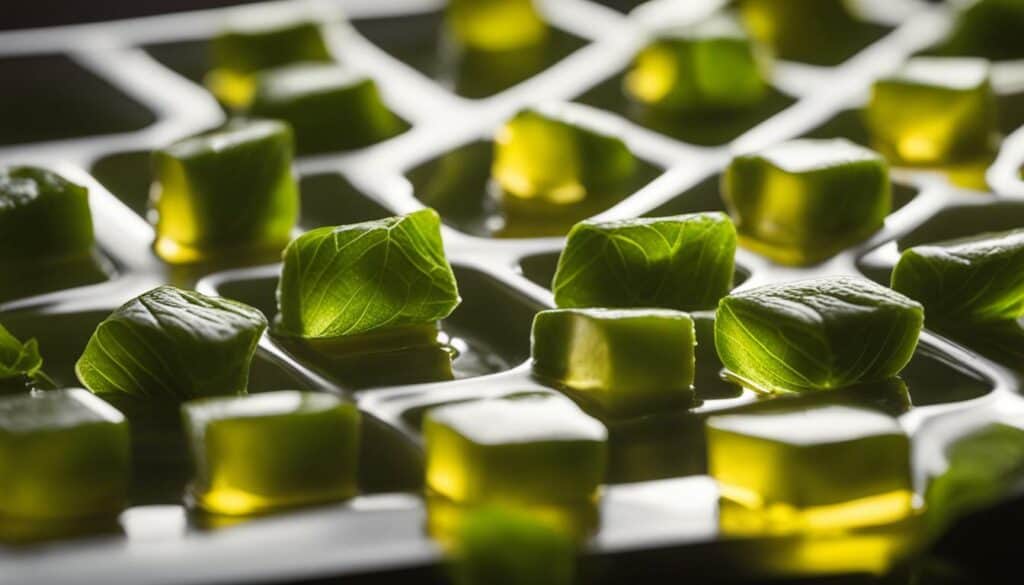
Salt Drying Basil
Basil can also be preserved by salt drying, where basil leaves are layered with salt in a jar and stored in the refrigerator. To start, harvest the basil in the morning when the essential oils are strongest. Make sure to clean the leaves thoroughly before drying to remove any dirt or pests that may be present.
After cleaning, layer the basil leaves with sea salt in a jar. The salt will draw out moisture from the leaves, preserving them for future use. Make sure to press down firmly on each layer to remove any air pockets.
| Steps for Salt Drying Basil | |
|---|---|
| Harvest basil in the morning | 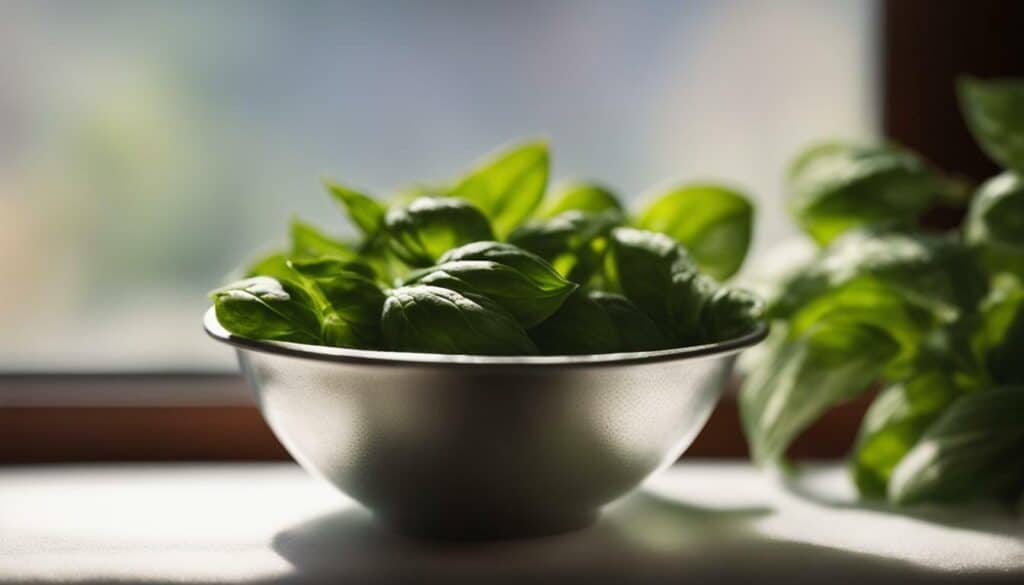 |
| Clean basil leaves thoroughly | |
| Layer basil leaves with sea salt in a jar | |
| Press down firmly on each layer to remove air pockets | |
| Store jar in the refrigerator for up to 6 months |
The salt-dried basil can be used to flavor dishes such as pasta sauces, soups, and stews. You can also use the salt itself as a seasoning in your cooking.
If you’re interested in making basil-infused olive oil, you can warm extra virgin olive oil with basil leaves after salt drying the leaves. Alternatively, you can make basil and olive oil cubes by cutting the leaves into small pieces and freezing them in ice cube trays with olive oil.
Dehydrating basil is another option for long-term preservation. Simply clean and dry the leaves before placing them in a dehydrator. Regular herb harvesting by pinching or pruning the stems promotes side shoot growth and increases yield, so don’t be afraid to cut off a few leaves here and there throughout the growing season.
Preserving basil leaves can not only provide you with delicious seasoning options year-round, it’s also a great way to reduce waste and get the most out of your garden. Try out salt drying or one of the other methods mentioned above to maximize your harvest.
Dehydrating Basil
Dehydrating basil is another method to preserve this flavorful herb and enjoy it all year round. It’s a great option for those who have a surplus of basil in their garden and want to store it for later use.
Before you begin, make sure to harvest your basil in the morning when the essential oils are strongest. This will ensure that the basil is at its most flavorful. Also, be sure to clean the leaves thoroughly, getting rid of any dirt or pests that may be hiding on them.
There are several methods you can use to dehydrate basil. One option is to lay the leaves out on a tray and leave them in a warm, dry place. Another option is to hang the basil upside down in a cool, dry place. If you have a dehydrator, you can also use that to dehydrate the leaves.
Regardless of the method you choose, make sure to dry the basil at a low temperature to preserve its flavor and color. The leaves should be completely dry and brittle before storing them in an airtight container.
Dehydrated basil can be used in various recipes, including sauces, soups, marinades, and seasoning blends. It’s a versatile herb that can add depth and flavor to many dishes. With these simple steps, you can enjoy the flavor of basil all year round.
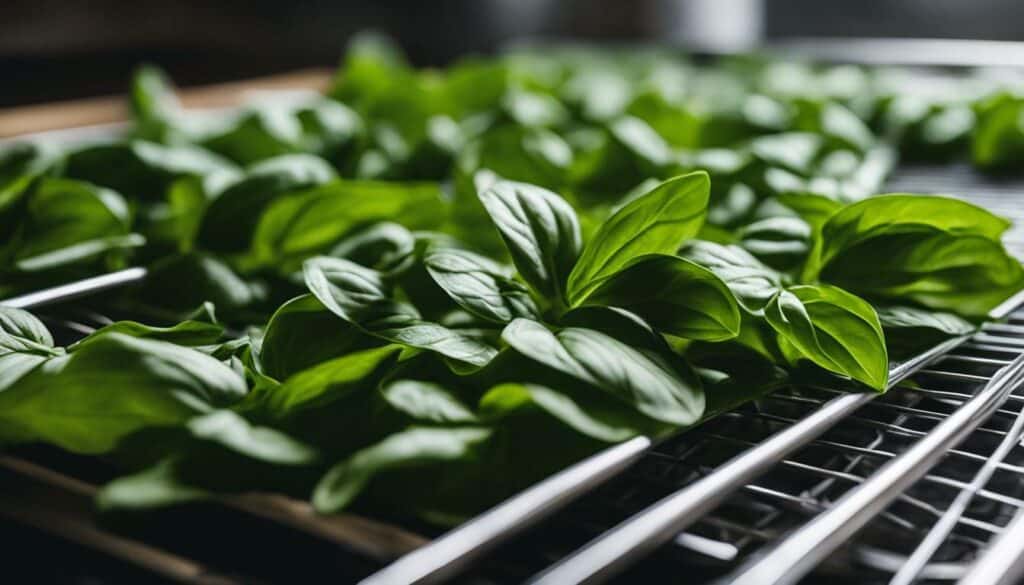
Whether you’re a seasoned cook or a novice in the kitchen, dehydrating basil is a great way to ensure that you always have this flavorful herb on hand. With its versatility and ease of use, you can add it to a wide range of dishes to enhance their flavor.
Regular Herb Harvesting for New Growth
Regular herb harvesting is essential for promoting new growth and ensuring a bountiful supply of flavorful herbs. When it comes to basil, one of the most popular culinary herbs, it is best to harvest in the morning when the essential oils are the strongest.
Before harvesting, it is important to clean the basil leaves thoroughly by hosing off any dirt or insects. This ensures that the herbs are free from any harmful pesticides or bacteria.
By harvesting regularly, you can encourage side shoot growth and increase yield. This means that instead of letting your basil grow tall and leggy, regular harvesting will promote a bushier, fuller plant.
It is recommended to harvest no more than one-third of the plant at a time, leaving enough leaves for the plant to continue to produce. Harvesting can be done with a sharp pair of scissors or shears, cutting the stem just above a pair of healthy leaves.
Overall, regular herb harvesting is crucial for maintaining a steady supply of fresh herbs and promoting new growth in your basil plants. By following these tips, you can enjoy a constant stream of delicious, fresh basil from your garden.
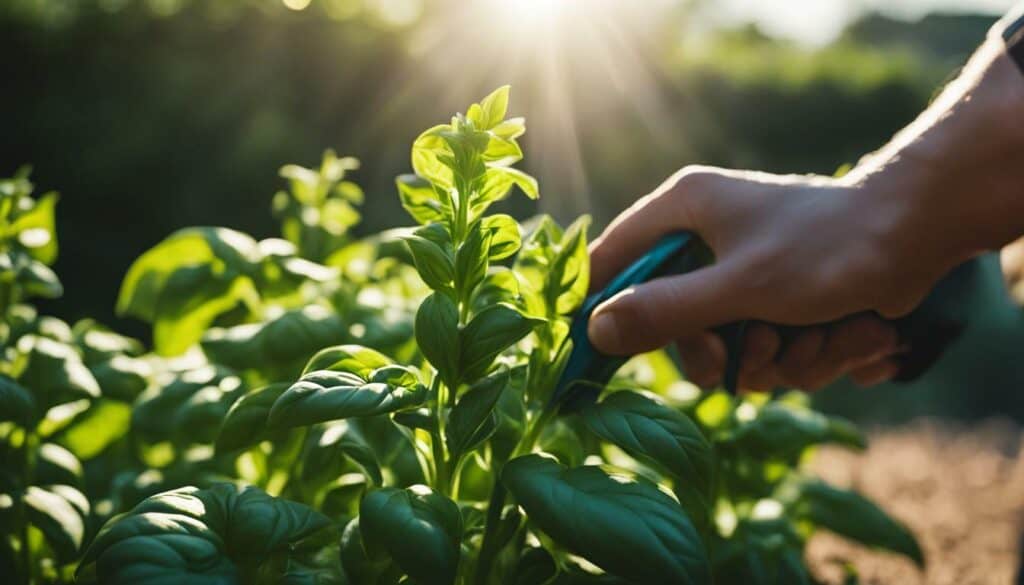
Harvesting Techniques for Different Types of Basil
Different types of basil, such as Genovese, Greek, Thai, and lemon basil, require slightly different harvesting techniques. However, the principles of harvesting remain the same for all types of basil. Harvesting should be done in the morning when the essential oils are at their strongest. This ensures a more potent and flavorful herb.
To start, remove any yellowed or damaged leaves from the plant. This will allow more energy to be directed towards the healthy leaves. Next, using a sharp pair of scissors, snip the stem just above a pair of leaves. This will encourage new growth from the cut stem. It’s important to avoid cutting too much of the plant at once as this can weaken it and reduce its yield.
For Genovese basil, the leaves should be harvested when they are about 3 inches long. This will ensure the best flavor and yield. Greek basil should be harvested when the leaves are about 2 inches long. Thai basil, on the other hand, can be harvested when the plant is about 6 inches tall. This will encourage branching and produce more leaves. Lemon basil should be harvested when the leaves start to curl at the edges. This indicates that they are at their most flavorful.
Regular harvesting is essential for all types of basil as it promotes new growth and prevents flowering. Flowering can reduce leaf production, so it’s important to pinch off any flower buds as soon as they appear. By harvesting regularly, basil growers can ensure a continuous supply of fresh, flavorful basil for their culinary delights.

Creative Ways to Use Fresh Basil
There are countless creative ways to use fresh basil in your culinary endeavors. Here are a few ideas to get you started:
- Make a classic Caprese salad with fresh mozzarella, sliced tomatoes, and basil leaves. Drizzle with olive oil and balsamic vinegar to finish.
- Create a homemade pesto by blending fresh basil, garlic, pine nuts, parmesan cheese, and olive oil in a food processor. Toss with pasta, spread on sandwiches, or use as a marinade.
- Add fresh basil leaves to your favorite cocktail for an unexpected twist of flavor. Try a basil-infused gin and tonic or a strawberry basil margarita.
- Top grilled fish or chicken with a mixture of chopped basil, garlic, lemon juice, and olive oil for a bright and flavorful sauce.
- Combine diced tomatoes, fresh basil, garlic, and olive oil for a quick and easy bruschetta topping. Serve on toasted baguette slices for a delicious appetizer or snack.
- Make a simple syrup infused with fresh basil to sweeten cocktails or lemonade.
- Add whole basil leaves to homemade pizza before baking for a burst of fresh flavor.
- Use fresh basil leaves to garnish soups, stews, or chili for a pop of color and extra flavor.
Preserving fresh basil using different methods allows you to enjoy its flavors all year round. Try making basil-infused olive oil, basil and olive oil cubes, salt-drying, or dehydrating for long-term storage. Remember to harvest basil in the morning when the essential oils are strongest and to regularly pinch or prune the stems to promote new growth. With these creative ideas and preservation techniques, you can maximize your harvest and savor the fresh flavors of basil for months to come.
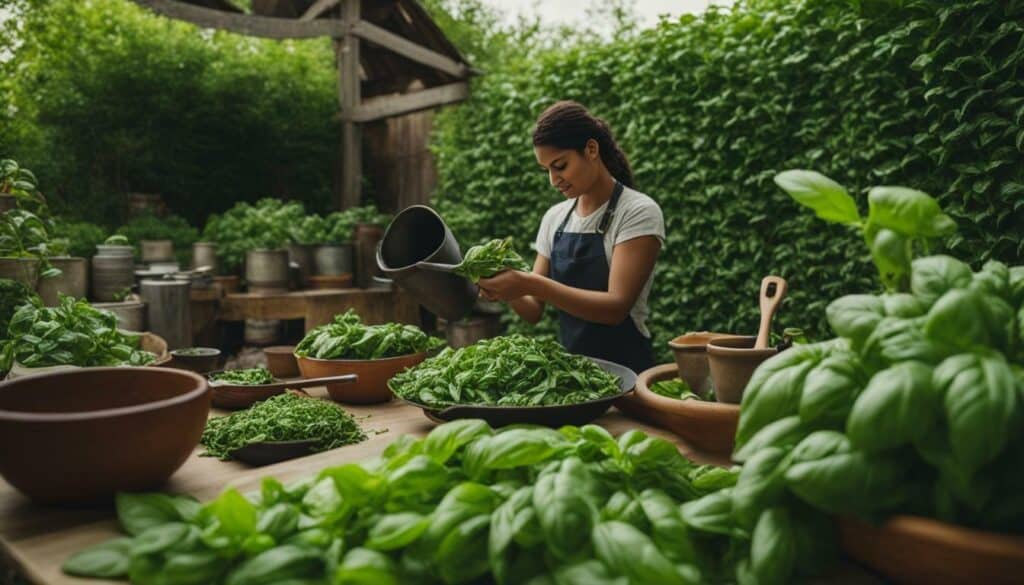
Additional Tips for Preserving Basil
Along with the preservation methods mentioned above, there are other ways to make the most of your fresh basil harvest. One method is to make basil vinegar by adding fresh basil leaves to white vinegar. This vinegar can be used in salad dressings and marinades. Another creative way to use fresh basil is to make a basil pesto and freeze it in ice cube trays for easy use in pasta dishes or as a topping for bruschetta.
If you’re looking for a quick and easy way to use up your basil harvest, try making a Caprese salad with fresh mozzarella, sliced tomatoes, and basil leaves. You can also infuse water or cocktails with basil for a refreshing twist on traditional drinks.
When preserving basil, it’s important to store it properly. Fresh basil can be stored in a vase of water like a bouquet of flowers, but make sure to change the water frequently. For longer storage, wrap fresh basil leaves in a damp paper towel and store them in the refrigerator.
Remember to get creative with your basil recipes and preservation methods. There’s nothing quite like the fresh, aromatic flavor of homemade basil-infused olive oil or the convenience of having frozen basil cubes on hand for quick and easy meals. With these preservation tips and recipe ideas, you can make the most of your fresh basil harvest all year round.
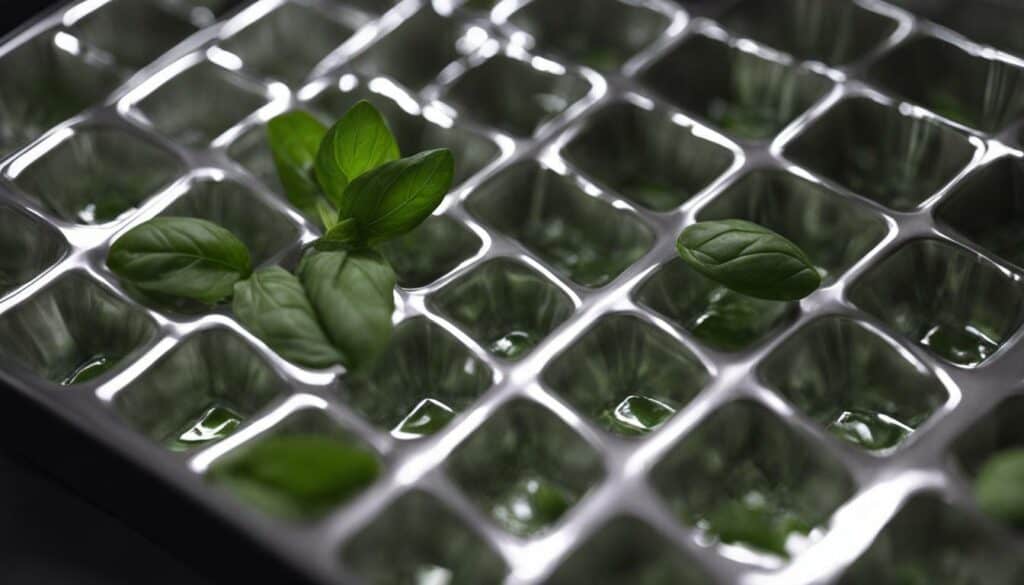
Conclusion
In conclusion, fresh basil from your garden can be turned into a delightful array of dishes, from basil-infused olive oil to flavorful recipes that will tantalize your taste buds. Harvesting basil at the right time of day and using proper techniques can ensure that your plants continue to produce throughout the growing season. It’s best to begin harvesting about a month after transplanting, and to continue until the first frost. Early to mid-morning is the ideal time to harvest basil, and different types of basil may require slightly different methods of harvesting. By regularly harvesting your basil and preserving it through techniques such as salt drying and dehydrating, you can enjoy the full flavor of this versatile herb all year round.
Whether you’re using fresh basil in a classic pesto recipe or experimenting with a new dish, this herb is sure to add a burst of delicious flavor to your meals. In addition to traditional recipes, there are many creative ways to use fresh basil, such as in cocktails, desserts, and even as a natural air freshener. And don’t forget about the benefits of preserving your basil in basil-infused olive oil for easy use in a wide variety of dishes.
Overall, whether you’re a seasoned gardener or just starting out, growing fresh basil is a great way to add a burst of flavor to your meals and enhance your culinary skills. So why not give it a try and start harvesting and using fresh basil from your garden today? With a little know-how and a touch of creativity, the possibilities are endless.
How Can I Use Fresh Basil in a Potato Basil Frittata Recipe?
Fresh basil adds a burst of flavor to the delectable potato basil frittata recipe by ina garten. Chop the basil and sprinkle it along with potato slices onto the beaten eggs. Finish by cooking the frittata to perfection, allowing the fragrant aroma of basil to infuse every delicious bite.
FAQ
Q: What is the best time to harvest basil?
A: The best time to harvest basil is in the morning when the essential oils are strongest.
Q: How should I clean basil leaves before preservation?
A: Thoroughly clean basil leaves by hosing off any dirt and insects.
Q: What is basil-infused olive oil?
A: Basil-infused olive oil is made by warming extra virgin olive oil with fresh basil leaves.
Q: How do I make basil and olive oil cubes?
A: Make basil and olive oil cubes by freezing chopped basil leaves in ice cube trays with olive oil.
Q: What is salt drying basil?
A: Salt drying basil is a preservation method where basil leaves are layered with salt in a jar and stored in the refrigerator.
Q: How do I dehydrate basil?
A: Clean, dry, and dehydrate basil leaves at a low temperature for long-term preservation.
Q: Why is regular herb harvesting important for basil plants?
A: Regular herb harvesting promotes new growth of basil plants.
Q: Are there different harvesting techniques for different types of basil?
A: Yes, different types of basil, such as Genovese, Greek, Thai, and lemon basil, may require slightly different harvesting techniques.
Q: What are some creative ways to use fresh basil?
A: Fresh basil can be used in various recipes, adding flavor to dishes like pasta, salads, and sauces. It can also be used in cocktails, infused water, or as a garnish.
Q: Any additional tips for preserving basil?
A: Store fresh basil in a glass of water like fresh flowers, or dry and store in an airtight container. Basil can also be made into pesto or used to make flavored oils and vinegars.
Source Links
- https://www.creativevegetablegardener.com/how-to-preserve-basil/
- https://preparednessmama.com/preserve-basil/
- https://savvygardening.com/harvesting_basil/
- https://getbusygardening.com/storing-basil/
- https://thehouseandhomestead.com/the-easy-way-to-grow-harvest-preserve-basil/
- https://getbusygardening.com/harvesting-basil/
- https://www.bhg.com/gardening/vegetable/herbs/how-to-harvest-basil/
- https://plantsomethingli.com/know-harvest-basil/
- https://cleaninup.com/how-to-clean-fresh-basil-from-garden/
- https://cooking.stackexchange.com/questions/23794/basil-to-wash-or-not-to-wash-best-practices
- https://www.homestratosphere.com/how-to-clean-basil-properly/
- https://sandhyahariharan.co.uk/basil-oil/
- https://food52.com/recipes/30516-basil-infused-olive-oil
- https://www.skinnytaste.com/basil-oil/
- https://www.savorymomentsblog.com/2021/08/how-to-freeze-basil-in-olive-oil.html?m=1
- https://champagne-tastes.com/how-to-freeze-basil/
- https://mortadellahead.com/how-to-freeze-basil-in-olive-oil-quick-and-easy-method/
- https://www.therisingspoon.com/2013/12/how-to-make-basil-salt-easy-diy-gourmet.html?m=1
- https://anitalianinmykitchen.com/preserve-fresh-basil/
- https://confessionsofanover-workedmom.com/what-to-do-with-fresh-basil/
- https://urbanfarmie.com/how-to-dry-fresh-basil-leaves/
- https://www.schneiderpeeps.com/3-simple-ways-of-drying-basil-at-home/
- https://www.alphafoodie.com/how-to-dry-basil-leaves/
- https://www.attainable-sustainable.net/harvesting-basil/
- https://www.almanac.com/plant/basil
- https://www.loveandlemons.com/basil/
- https://www.thepioneerwoman.com/food-cooking/meals-menus/g43978726/basil-recipes/
- https://www.foodnetwork.com/recipes/photos/our-best-basil-recipes
- https://www.themediterraneandish.com/how-to-store-fresh-basil/
- https://www.allrecipes.com/article/how-to-store-and-preserve-fresh-basil/
- https://thefreerangelife.com/preserve-basil/
- https://rennieorchards.com/harvesting-and-preserving-basil/

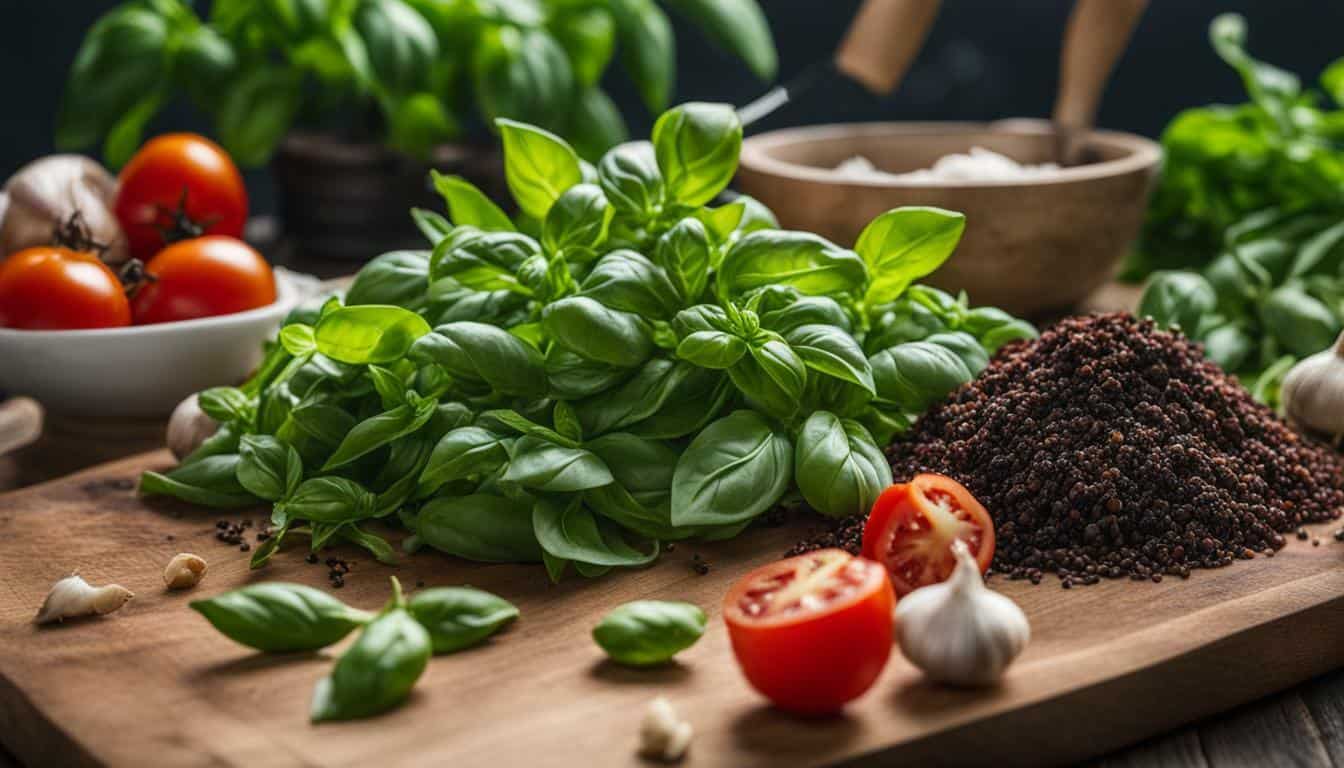



Leave a Reply